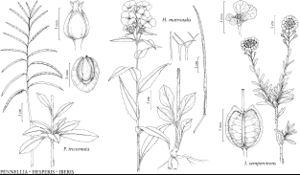Hesperis
Sp. Pl. 2: 663. 1753.
Gen. Pl. ed. 5, 297. 1754.
| Taxon | Illustrator ⠉ | |
|---|---|---|
 | Pennellia tricornuta Hesperis matronalis Iberis sempervirens | Yevonn Wilson-Ramsey Yevonn Wilson-Ramsey Yevonn Wilson-Ramsey |
Plants with caudex; not scapose; pubescent or glabrous, trichomes simple and/or forked, often mixed with unicellular glands on uniseriate stalks. Stems erect, unbranched or branched. Leaves basal and cauline; petiolate [sessile]; basal rosulate [not rosulate], blade margins entire, dentate, or pinnatifid; cauline similar to basal. Racemes (corymbose), considerably elongated in fruit. Fruiting pedicels divaricate or ascending [reflexed], slender or stout. Flowers: sepals oblong [linear], (sometimes connivent), lateral pair strongly saccate basally, (pubescent or glabrous); petals obovate [oblong], (much longer than sepals), claw distinctly differentiated from blade, (apex rounded [obtuse]); stamens strongly tetradynamous; filaments (erect), slender or dilated basally; anthers linear [oblong], (apex obtuse); nectar glands (2), lateral, annular or lunar. Fruits tardily dehiscent, sessile, linear, torulose; valves each with prominent midvein, glabrous; replum rounded; septum complete; ovules 4–40 per ovary; style obsolete or distinct (relatively short); stigma conical (lobes prominent, connivent or distinct, decurrent). Seeds plump, not winged, oblong; seed-coat (reticulate), not mucilaginous when wetted; cotyledons incumbent.
Distribution
Introduced; se Europe, c, sw Asia, n Africa, also in South America (Argentina), also in South America (Chile)
Discussion
Species 25 (1 in the flora).
Selected References
Lower Taxa
"elongated" is not a number."thick" is not a number.